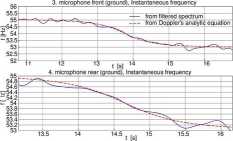6837092893
Diagnostyka’ 4(48)/2008
DYBAŁA, GAŁĘZIĄ, MĄCZAK, Verification Of Doppler EffectRemovalMethodFor The Needs Of...

To do this an instanlaneous freąuency fR should be calculated from tlie analytical signal of the passband filtered signal [3]
x.(t>= x(t)+j.H[x(D] (3)
using well known eąuation [3]
<4)
2-n dt
The passband of the filter should be selected in such manner as to remove from the signal all the freąuencies except the single smeared freąuency. For the signal from Fig. 5B a passband of 52-56 Hz was selected (Fig. 6B).
It is always a problem to design a digital filter with steep enough cliaracteristic and a veiy narrow passband. In this application a filtering was performed using Fourier transform, removing all the freąuencies except tlie desired passband and then applying irn erse Fourier Transform to thus modified spectrum.
Results of calculating the instantaneous freąuency for both front and rear ground pass-by station inicrophones are shown on Fig. 7. The signals are shifted in tiine for the equivalence of the axle distance (see Fig. 2, 3) The great similarity of the theoretical curves calculated from eąuation (1) and the curves calculated from the filtered spectrum (4) are the confinnation of tire correctness of the method.
The spectra of this signals look extremely similar to tlie one presented on the Fig. 6C.

Fig. 7. Cliange of instantaneous freąuency of 54 Hz according to eąuations (1) and (4)

Fig. 8. Comparison of described Doppler's Effect removal methods
4. SUMMARY
Results of the experiment confirmed tlie possibility of Doppler Effect's removal from the real signal in the field ineasurements. The difference between results obtained with theoretical freąuency curve and curve obtained using signal filtration differs only in maximum 5% (Fig. 8).
It was not the aim of this project to diagnose tlie technical State of the vehicle used in the experiment. The diesel engine used by the vehicle was noisy to such extent that it masked the bearings signals.
Described methods could be used in the devclopment of the ground pass-by vehicle diagnostic station capable of monitoring tlie technical State of passing vehicles.
REFERENCES
[1] Dybała J.: Use of task oriented dynamie resampling in reduction of signal non-stationarity. Diagnostyka 4(48)/2008. str.25-30.
[2] Mączak J.: Utilization of the GPS receivers for data synchronization in distributed signal acąuisition systems. In this issue.
[3] Dybała J., Mączak J„ Radkowski S.: The use of vibroacoustic signal in technical risk analysis. Wydawnictwo Instytutu Technologii Eksploatacji PIB. Warszawa-Radom, 2006 (in polish)
Jacek DYBAŁA. PhD - is an assistant professor at the Institute of Machinę Design Fundamentals of the Warsaw University of Technology. His scientific interests are: technical
• diagnostics, macliine vibro-^ jł acoustic, signal analysis, paltem recognition and neural nctworks. Mcmbcr of the ■ Polish Socicl\ of Technical Diagnostics.
Jędrzej MĄCZAK. PhD is an assistant professor at the Institute of Machinę Design Fundamentals of the Warsaw University of
Technology. His scientific interests are distributed
diagnostic systems,
mathematical modelling of power units and methods of analysis of vibroacoustic signals.
Adam GAŁĘZIA is PhD
student in the Faculty of Automotive and Construction Machineiy Engineering at Warsaw University of Technology.
Wyszukiwarka
Podobne podstrony:
Diagnostyka’ 4(48)/2008 DYBAŁA, GALĘZIA, MĄCZAK, I erificalion Of Doppler Effect Removal AleihodFor
Diagnostyka’ 4(48)/2008 DYBA!A, GALĘZIA, MĄCZAK, 1 erification Of Doppler Effect ReniovalMełhodFor T
Diagnostyka’ 4(48)/2008 7 DYBAŁA, GALĘZIA, MĄC7.AK, Yerification Of Doppler Effect
Diagnostyka’ 4(48)/2008 KEKEZ, AMBROZIK, RADZISZEWSKI, Modeling of Cylinder Pres surę in Compression
10 Diagnostyka’ 4(48)/2008 KEKEZ, AMBROZIK, RADZISZEWSKI, Modeling of Cylinder Pre
12 Diagnostyka’ 4(48)/2008 KEKEZ, AMBROZIK, RADZISZEWSKI, Modeling of Cylinder Pre
14 Diagnostyka’ 4(48)/2008 KEKEZ, AMBROZIK, RADZISZEWSKI, Modeling of Cylinder Pre
16 Diagnostyka’ 4(48)/2008 KEKEZ, AMBROZIK, RADZISZEWSKI. Modeling of Cylinder Pre
Diagnostyka’ 4(48)/2008 11 KEKEZ, AMBROZIK, RADZISZEWSKI, Modeling of Cylinder Pre
Diagnostyka’ 4(48)/2008 13 KEKEZ, AMBROZIK, RADZISZEWSKI, Modeling of Cylinder Pre
Diagnostyka’ 4(48)/2008 15 KEKEZ, AMBROZIK, RADZISZEWSKI, Modeling of Cylinder Pre
17 Diagnostyka 4(48)/2008 BARSZCZ, MASKA, Application of Hardware-In-Loop for 11irtualPower
Diagnostyka 4(48)/2008 Spis treści / Contents Jubileuszprof. Lesława BĘDKOWSKIEGO / Jubilee of Profe
Diagnostyka 4(48)/2008 Spis treści/ Contents Jędrzej MĄCZAK - Politechnika
Diagnostyka’ 4(48)/2008 Jubileusz prof. Lesława BĘDKOWSKIEGO / Jubilee of Profesor Lesław
Diagnostyka’ 4(48)/2008 BARSZCZ, MAŃKA, Application ofHardware-In-Loop for 1 irlual Power Piani •
Diagnostyka’ l(45)/2008 RYBCZYŃSKI, Maps offolerable Misalignments of Bearings Applicable...MAPS OF
12 Diagnostyka’ l(45)/2008 RYBCZYŃSKI, Maps ofTolerable Misalignments of Bearings
14 Diagnostyka’ l(45)/2008 RYBCZYŃSKI, Maps ofTolerable Misalignmenls of Bearings
więcej podobnych podstron